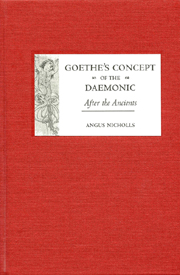Book contents
- Frontmatter
- Contents
- Editions and Abbreviations
- Acknowledgments
- Introduction
- 1 The Ancients and Their Daemons
- 2 The Daemonic in the Philosophy of the Sturm und Drang: Hamann and Herder
- 3 Romanticism and Unlimited Subjectivity: “Mahomets Gesang”
- 4 Werther: The Pathology of an Aesthetic Idea
- 5 Kantian Science and the Limits of Subjectivity
- 6 Schelling, Naturphilosophie, and “Mächtiges Überraschen”
- 7 After the Ancients: Dichtung und Wahrheit and “Urworte. Orphisch”
- 8 Eckermann, or the Daemonic and the Political
- Epilogue: Socrates and the Cicadas
- Works Cited
- Index
4 - Werther: The Pathology of an Aesthetic Idea
Published online by Cambridge University Press: 05 February 2013
- Frontmatter
- Contents
- Editions and Abbreviations
- Acknowledgments
- Introduction
- 1 The Ancients and Their Daemons
- 2 The Daemonic in the Philosophy of the Sturm und Drang: Hamann and Herder
- 3 Romanticism and Unlimited Subjectivity: “Mahomets Gesang”
- 4 Werther: The Pathology of an Aesthetic Idea
- 5 Kantian Science and the Limits of Subjectivity
- 6 Schelling, Naturphilosophie, and “Mächtiges Überraschen”
- 7 After the Ancients: Dichtung und Wahrheit and “Urworte. Orphisch”
- 8 Eckermann, or the Daemonic and the Political
- Epilogue: Socrates and the Cicadas
- Works Cited
- Index
Summary
In an essay on Die Leiden des jungen Werther, Thomas Mann gives the following description of the novel's author:
Goethe … der Dichter, das Genie, der treuherzige und aufrichtige, aber auch wieder treulose und in irdischem Sinne unzuverlässige Vagabund des Gefühls … der junge Dämon, der im “Faust” von sich sagt: “Bin ich der Flüchtling nicht? Der Unbehauste? Der Unmensch ohne Zweck und Ruh?” — Ein liebenswürdiger Unmensch: schön, hochbegabt, geladen mit Geist und Leben, feurig, gefühlvoll, ausgelassen und schwermütig, kurz — närrisch in einem lieben Sinn.
Mann's portrayal of Goethe, and the passage from part two of Faust with which he supplements it, both correspond with the official Goethe-endorsed mythology that surrounds Werther. In this scenario, Goethe is seen as the fiery young Stürmer und Dränger; a figure compared to a “Wassersturz” that has stormed “von Fels zu Felsen … / Begierig wütend nach dem Abgrund zu” (FA 1,7/1:144). It is no coincidence that we find in the passage from Faust quoted by Mann a similar image of rushing water to that which appears in “Mahomets Gesang,” as the biographical mythology surrounding the composition of Werther corresponds with the model of subjectivity outlined in Goethe's early poem. Hence we are presented with a biographical narrative in which Goethe, inspired with Romantic longing and endowed with an excess of natural creativity, feverishly wrote Werther in order to exorcize himself of his overweening, transgressive, and dangerously anti-social subjectivity.
- Type
- Chapter
- Information
- Goethe's Concept of the DaemonicAfter the Ancients, pp. 142 - 166Publisher: Boydell & BrewerPrint publication year: 2006

